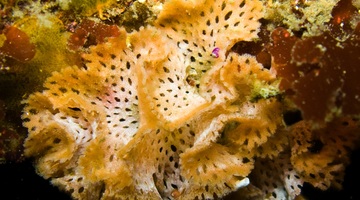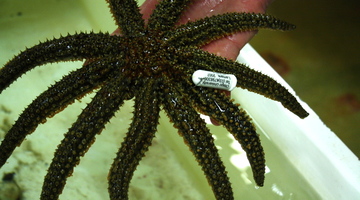Sea stars have many weird and wonderful adaptations including both sexual and asexual reproduction. Click on any of the labels in this interactive to view short video clips or images to learn more.
Select here to view the full transcript and copyright information.

Sea stars have many weird and wonderful adaptations including both sexual and asexual reproduction. Click on any of the labels in this interactive to view short video clips or images to learn more.
Don’t forget to flip the sea star over and see what’s underneath – the ventral view!
Transcript
Spines
Sea stars are echinoderms, which means ‘spiny skin’. Most sea stars have rows of spines (or tiny spines called spicules) on their topside for protection from predators. Some sea stars also have shorter spines underneath, alongside their tube feet.
Acknowledgement: The University of Waikato Te Whare Wānanga o Waikato
Asexual reproduction
DR MILES LAMARE
As opposed to producing a larval stage, they can actually just decide, “Well, I'm going to cut myself in half and make two of me.” That’s called asexual reproduction – the scientific name for that’s called fission. And so when conditions are right and the starfish feels some need to increase its population size, it can do it by basically just splitting itself in half and the two halves growing a new body.
Red spots
DR MILES LAMARE
They have things called red spots on the end of their arms, which basically can detect shades of intensity. So you know, if we were to move our hand over them, they would detect that the light had dropped and something was moving around.
Note: Red spots are also referred to as “eye spots”, they are located on the tips of their arms where their underside meets the top side.
Starfish larvae
DR MILES LAMARE
When these animals reproduce, they release a free-swimming stage – it’s a microscopic larval stage – and that is in the water column, moving around for weeks or months, depending on what species you’re dealing with. And that’s a way that the animal can basically colonise different areas. It releases the larvae, they get washed away, then they settle out and turn into little starfish and grow up.
Regeneration
DR MILES LAMARE
If a fish comes along and starts attacking a starfish – it might grab it by the arm – the starfish will happily let go of that arm through a process called autotomy, and it will just regrow that arm. So they have very good powers of regeneration. In fact, there’s research going on trying to understand how they can regenerate so well. Perhaps there could be some medical applications for us.
Chemical defences
DR MILES LAMARE
Starfish also have nasty chemicals in them, which act as a chemical defence to predation, so something might try and bite it but they’ll spit it out because they don't taste very nice. And there’s one particular tropical species called the crown-of-thorns starfish, and if you were to touch it, you would get quite a nasty burn on your hand just through chemical defences.
Sense of smell
DR MILES LAMARE
They are very good at detecting chemical signals. In other words, they can smell very well, and they can basically smell where food… through the chemicals being released by their food getting washed down to them in currents, and they can use that current and that smell to basically move up and find their food – very good chemical reception or chemo-sensory structures.
Useful links
Most sea stars have eyes on the tips of their arms. Learn more about these ‘eye spots’ in this blog by Ed Yong.
To extend learners, look inside a sea star to see the inner workings of an animal very different from us in this animation, Sea star body plan.




